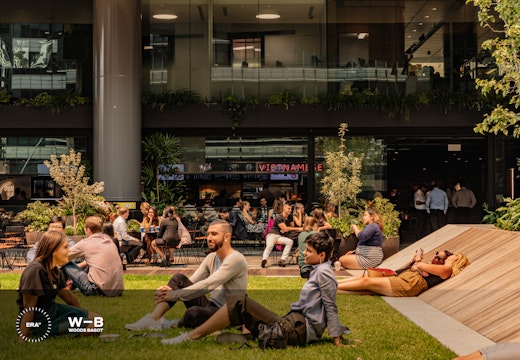How Innovation Districts can help us out of the pandemic
The challenges of the pandemic demand more innovative urban solutions. The development of new Innovation Districts could revitalise our cities and spark new conversations and ideas around urban planning
Innovation districts offer a way to catalyse learning, invention, and economic growth by facilitating meaningful knowledge exchange networks. They also have the potential to forge new livelihoods, better prepare future generations, and create culturally and economically diverse mixed-use neighbourhoods.
A research report by Woods Bagot, backed by experience consultancy ERA-co, has highlighted how Innovation Districts can help us overcome some of the challenges presented to urban areas by the pandemic. The report called ‘Urban Innovation: Building 24/7 Innovation Districts’ explores how urban planners and designers should strategically think about how to create spaces to spark conversation and innovation.
Changing higher education
The design of Innovation Districts starts with identifying the key players within the district. This includes the next generation of innovators: students.
Ten years ago, a survey by Gallup found 77 per cent of students in grades 5 through 12 said they wanted to be their own boss, 45 per cent planned to start their own business, and 42 per cent said they would invent something that changes the world. Today, many of those students are reaching university age – demanding a campus that helps them fulfil their entrepreneurial aspirations by providing them with essential resources and like-minds to collaborate with.
Despite this, some traditional education spaces still largely support the myth of the lone genius – featuring discipline-based floors and buildings that deliberately keep occupants in separate, subject-based fortresses.
‘Now is the time for entrepreneurs to help cities tackle some of the greatest urban challenges…’
Now more than ever, learning spaces need to be purpose-built for innovation. Designers, planners, and architects must create ways for students and researchers to influence each other, to incubate shared and diverse talents, and to associate with a plethora of disciplines and expertise. Universities of the future must develop into generative places where ideas can be tested, implemented, disassembled, and recreated – ultimately connecting with industry, governments, and communities.
The report goes on to highlight five ways in which Innovation Districts can be built to help overcome some of the challenges presented by the pandemic:
Co-location – Strategically placing key players in one central location creates ample opportunity for university staff and students to connect with researchers, local and international businesses, government and start- up companies.
Modular flexibility that adapts to change – Innovation Districts need to be able to respond to the evolving physical needs and capacities of their users over time. Shared amenities and floorspace – breakout, food and beverage, meeting and presentation spaces – double down on creating opportunities for spontaneous conversation.
Investment for cities – Innovation Districts provide a unique model for how aging assets can be restored and revitalised to bridge together mixed-use housing, office, retail, transit, and a robust technology infrastructure to contribute towards placemaking and improve communities.
Fostering the collective hive, physically and digitally – To be successful, future innovation districts must work on three levels: digital, programmatic and as a stage. The digital level would enable the creation of networks beyond those that physically occupy the space by connecting like-minded individuals. The programmatic level choreographs the space with a strong consideration for how users might use and travel through the district and creates relationships between relevant offerings. The physical infrastructure must be able to bring all the required people and activities into formation and provide a platform for their diverse requirements.
Creating hyper-local cultural and economic incubators – Future innovation districts should reflect their adjacent neighbourhoods by speaking to the cultural connection and history of the places they inhabit – thereby inclusively representing the wider community.
Revitalising neighbourhoods – Innovation districts also present an opportunity for the public sector to invest in revitalising abandoned industrial assets to create thriving place-based innovation ecosystems.
There has never been a more pressing time for entrepreneurs to help our cities tackle some of the greatest challenges of the 21st century and innovation districts have a significant role to play in addressing global social, economic, and environmental challenges.
Mitigating these challenges will require an innovative approach to investing in our communities that fosters more diverse economic growth, promotes social equity, and taps into communities of practice to solve these complex and interconnected crises.
Read the full Woods Bagot report here.








